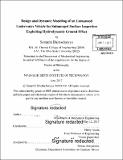| dc.contributor.advisor | Harry Asada. | en_US |
| dc.contributor.author | Bhattacharyya, Sampriti. | en_US |
| dc.contributor.other | Massachusetts Institute of Technology. Department of Mechanical Engineering. | en_US |
| dc.date.accessioned | 2019-11-12T17:41:18Z | |
| dc.date.available | 2019-11-12T17:41:18Z | |
| dc.date.copyright | 2017 | en_US |
| dc.date.issued | 2017 | en_US |
| dc.identifier.uri | https://hdl.handle.net/1721.1/122882 | |
| dc.description | Thesis: Ph. D., Massachusetts Institute of Technology, Department of Mechanical Engineering, 2017 | en_US |
| dc.description | Cataloged from PDF version of thesis. | en_US |
| dc.description | Includes bibliographical references (pages 224-233). | en_US |
| dc.description.abstract | Anticipated growth of sub-sea technologies for security, infrastructure inspection, and exploration, motivates a deeper understanding of underwater navigation in proximity to a submerged target surface. Common examples range from water tanks in nuclear reactors, submerged oil rig infrastructure, to ship hulls with hidden compartments and threats. We propose EVIE (Ellipsoidal Vehicle for Inspection and Exploration): a water jet propelled, football sized ellipsoidal Unmanned Underwater Vehicle (UUV) with a flattened base to house necessary sensors needed for surface inspections. The UUV is designed - both in terms of its shape and propulsion - for gliding on submerged surfaces for volumetric inspection, in addition to motion in free stream motion for visual inspections. This thesis research explores the ground effect hydrodynamics due to the motion of a body near a surface. | en_US |
| dc.description.abstract | We demonstrate the formation of a thin fluid bed layer between the surfaces which enables smooth motion even on rough surfaces. The proposed robot eliminates the need for wheels or suction. Use of ground effect fluid dynamics is common in aerial and land vehicles but is almost unexplored for underwater applications. We focus exploiting this phenomenon in real world applications, developing a prototype model to maintain precise distances with reduced actuator control. We explore both parasitic (induced by lateral motion) and explicitly induced (adding a impinging bottom jet) hydrodynamic effects. We find the force is not only non linear, it is not monotonic and has multiple equilibria. As the body approaches the surface it first experiences repulsion (enhanced thrust) due to an up-wash effect - similar to vertical take off and landing (VTOL) vehicles which can hover at reduced thrust. This transitions to a suction force at small distances from a Venturi effect. | en_US |
| dc.description.abstract | At still smaller distances there is again a repulsion due to choking flow between the body and the surface. Given the complexity of the force, and considering the hydrodynamic drag is non linear as well, traditional linearization fails to capture the system behavior and is at best constrained to a small region around the equilibrium. Instead, we use a higher dimensional, data driven approach for modeling. The underlying hypothesis is that dynamical systems behave linearly when recast in a suitable higher dimensional space. State variables are augmented by adding auxiliary variables that sufficiently inform the nonlinear dynamics of the system. We demonstrate a novel and a powerful method of individual estimation of each of the state dependent non linearities by integrating a state estimator into the augmented system. The estimator only uses measured, original states to estimate the non linear forces. | en_US |
| dc.description.abstract | The method is extremely robust: even though the approximated state transition model has significant inaccuracies, we prove guaranteed convergence of the unobserved states. This doctoral thesis encompasses three unique contribution: design and development of a prototype micro UUV platform for testing surface inspection methods; invention and application of a unique underwater phenomenon to the UUV; and establishing a novel mathematical approach for robust estimation of complex non linear elements using a linearized, high dimensional data driven model. The research presented opens a whole new door of opportunities and provides a new perspective for the design of next generation subsea vehicles and technology. | en_US |
| dc.description.statementofresponsibility | by Sampriti Bhattacharyya | en_US |
| dc.format.extent | 233 pages | en_US |
| dc.language.iso | eng | en_US |
| dc.publisher | Massachusetts Institute of Technology | en_US |
| dc.rights | MIT theses are protected by copyright. They may be viewed, downloaded, or printed from this source but further reproduction or distribution in any format is prohibited without written permission. | en_US |
| dc.rights.uri | http://dspace.mit.edu/handle/1721.1/7582 | en_US |
| dc.subject | Mechanical Engineering. | en_US |
| dc.title | Design and dynamic modeling of an unmanned underwater vehicle for submerged surface inspection exploiting hydrodynamic ground effect | en_US |
| dc.type | Thesis | en_US |
| dc.description.degree | Ph. D. | en_US |
| dc.contributor.department | Massachusetts Institute of Technology. Department of Mechanical Engineering | en_US |
| dc.identifier.oclc | 1126663031 | en_US |
| dc.description.collection | Ph.D. Massachusetts Institute of Technology, Department of Mechanical Engineering | en_US |
| dspace.imported | 2019-11-12T17:41:17Z | en_US |
| mit.thesis.degree | Doctoral | en_US |
| mit.thesis.department | MechE | en_US |
